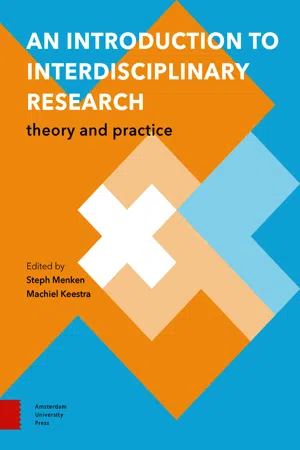
eBook - PDF
An Introduction to Interdisciplinary Research
Theory and Practice
This is a test
- 128 pages
- English
- PDF
- Available on iOS & Android
eBook - PDF
Book details
Book preview
Table of contents
Citations
Frequently asked questions
At the moment all of our mobile-responsive ePub books are available to download via the app. Most of our PDFs are also available to download and we're working on making the final remaining ones downloadable now. Learn more here.
Both plans give you full access to the library and all of Perlego’s features. The only differences are the price and subscription period: With the annual plan you’ll save around 30% compared to 12 months on the monthly plan.
We are an online textbook subscription service, where you can get access to an entire online library for less than the price of a single book per month. With over 1 million books across 1000+ topics, we’ve got you covered! Learn more here.
Look out for the read-aloud symbol on your next book to see if you can listen to it. The read-aloud tool reads text aloud for you, highlighting the text as it is being read. You can pause it, speed it up and slow it down. Learn more here.
Yes, you can access An Introduction to Interdisciplinary Research by Machiel Keestra, Steph Menken in PDF and/or ePUB format, as well as other popular books in Education & Education General. We have over one million books available in our catalogue for you to explore.
Information

16
Chapter
1
Introduction
In
their
experiments,
they
found
that
psychological
traits
like
bad
character
or
low
intelligence
could
not
explain
why
poor
people
made
more
bad
decisions
than
people
with
more
financial
resources.
Instead,
Shafir
and
Mullainathan
came
up
with
another
explanation:
It
is
often
a
person’s
context
that
dictates
whether
someone
can
make
a
good
decision.
Shafir
again:
“Slowly
came
the
realization
that
many
of
the
mistakes
made
by
the
poor
are
caused
by
poverty
itself.”
In
their
book,
the
researchers
explain
that
when
someone
experiences
scarcity
–
whether
it
is
a
lack
of
money,
friends
or
time
–
this
shortage
‘captures’
that
person’s
mind.
Her
mind
will
intentionally
and
unintentionally
deal
with
scarcity,
and
this
leaves
less
cognitive
capacity
for
other
things,
such
as
making
a
good
decision.
Table of contents
- Contents
- Acknowledgements
- Preface
- Part 1. The Handbook – ‘The What’
- 1. Introduction
- 2. What is science? A brief philosophy of science
- 3. The disciplines
- 4. Interdisciplinarity
- 5. Complexity: the main driving force behind interdisciplinarity
- 6. Interdisciplinary integration
- Part 2. The Manual – ‘The How’
- 7. The interdisciplinary research process
- 8. The problem
- 9. Theoretical framework and research question1
- 10. How to collect and analyze your data
- 11. Discussion and conclusion(s)
- Part 3. Interdisciplinary research in practice
- 12. Interdisciplinary research example: fogponics
- 13. Interdisciplinary careers
- Further reading
- References